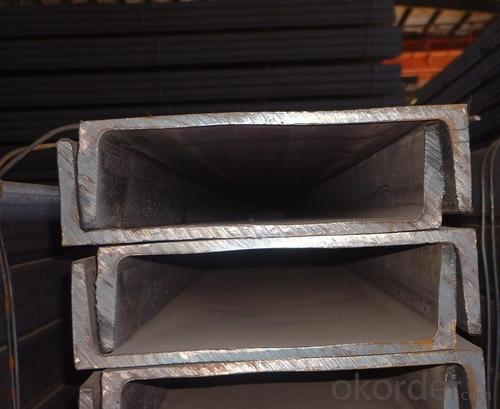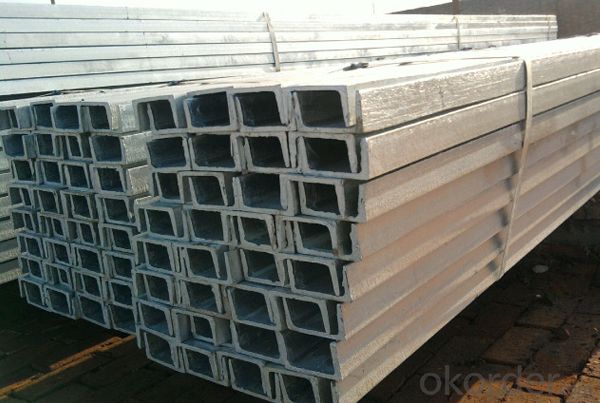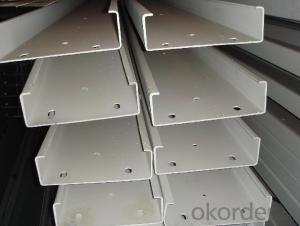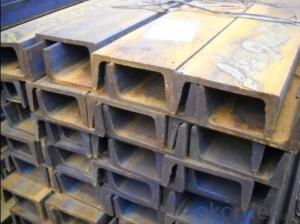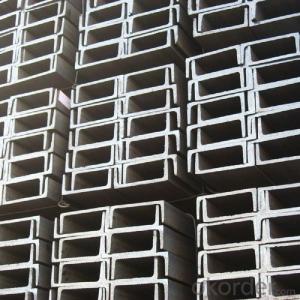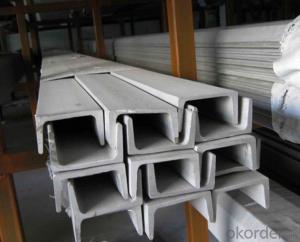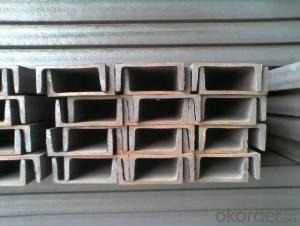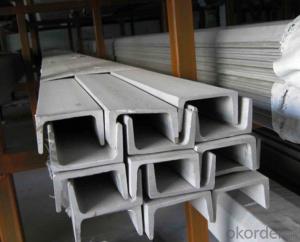JIS U CHANEEL 5-300mm or High Quality Hot Rolled
- Loading Port:
- China Main Port
- Payment Terms:
- TT or LC
- Min Order Qty:
- -
- Supply Capability:
- -
OKorder Service Pledge
OKorder Financial Service
You Might Also Like
Product Description:
OKorder is offering high quality JIS U CHANEEL 5-300mm or High Quality Hot Rolledat great prices with worldwide shipping. Our supplier is a world-class manufacturer of steel, with our products utilized the world over. OKorder annually supplies products to European, North American and Asian markets. We provide quotations within 24 hours of receiving an inquiry and guarantee competitive prices.
Product Applications:
1.The JIS U Channel Steel can be devided into two kinds, namely common channel steel and light channel steel. The sizes of hot rolled common channel steel range from 5# to 40#. Meanwhile, the channel steel can be divided into cold forming sectional equal channel steel, cold forming sectional unequal channel steel, cold forming inner edge channel steel and outer edge channel steel.
2.The JIS u channel steel is usually used for arch-itechtural structure, and they could be welded in order to support or hang a vari-ety of facilities. They are also usually used in combination with I beam. The channel steel with sizes under 14# is usually applied to construction engineering, as purline, while the channel steel with sizes above 16# is more likely to be used in building vehicle chassis structure and mechanical structure. Furthermore, the channel steel in sizes above 30# are target at building bridge structure, as tension bar.
3.In a word, the channel steel must possess perfect welding property, riveting property and mechanical property and so on.
Product Advantages:
OKorder's JIS U CHANEEL 5-300mm or High Quality Hot Rolledare durable, strong, and resist corrosion.
Main Product Features:
· Premium quality
· Prompt delivery & seaworthy packing (30 days after receiving deposit)
· Corrosion resistance
· Can be recycled and reused
· Mill test certification
· Professional Service
· Competitive pricing
Product Specifications:
Manufacture: Hot rolled
Grade: Q195 – 235
Certificates: ISO, SGS, BV, CIQ
Length: 6m – 12m, as per customer request
Packaging: Export packing, nude packing, bundled
Original Place | Tangshan, China | Brand Name | UINDA |
Standard | JIS G3192 : 1990 | ||
Material Grade | SS490 | ||
Sizes | 50mm to 200mm | ||
Sales Volume/Year | 3000MT | ||
Destination Area | Middle East, Africa, Southeast Asia | ||
2. The sections in details are as followings in the table-1
JIS U CHANNEL | Standard | Sectional | Dimension |
| Mass: |
| (mm) | (mm) | (mm) | (mm) |
|
50x25 | 50 | 25 | 3.0 | 6.00 | 2.37 |
75X40 | 75 | 40 | 3.8 | 7.00 | 5.30 |
75X40 | 75 | 40 | 4.0 | 7.00 | 5.60 |
75X40 | 75 | 40 | 4.5 | 7.00 | 5.85 |
75X40 | 75 | 40 | 5.0 | 7.00 | 6.92 |
|
|
|
|
|
|
100X50 | 100 | 50 | 3.8 | 6.00 | 7.30 |
100X50 | 100 | 50 | 4.2 | 6.00 | 8.03 |
100X50 | 100 | 50 | 4.5 | 7.50 | 8.97 |
100X50 | 100 | 50 | 5.0 | 7.50 | 9.36 |
|
|
|
|
|
|
125X65 | 125 | 65 | 5.2 | 6.80 | 11.66 |
125X65 | 125 | 65 | 5.3 | 6.80 | 12.17 |
125X65 | 125 | 65 | 5.5 | 8.00 | 12.91 |
125X65 | 125 | 65 | 6.0 | 8.00 | 13.40 |
|
|
|
|
|
|
150x75 | 150 | 75 | 5.5 | 7.30 | 14.66 |
150x75 | 150 | 75 | 5.7 | 10.00 | 16.71 |
150x75 | 150 | 75 | 6.0 | 10.00 | 17.90 |
150x75 | 150 | 75 | 6.5 | 10.00 | 18.60 |
150x75 | 150 | 75 | 6.5 | 10.00 | 24.00 |
|
|
|
|
|
|
200X80 | 200 | 80 | 7.5 | 11.00 | 24.60 |
3. The mechanical property of JIS U Channel Steel in the table-2:
Grade | Yield Strength,N/mm² | Extension Strength N/mm² | |||
Thickness of Steel,mm | |||||
≦16 | >16-≦40 | >40-≦100 | >100 | ||
SS490 | ≧285 | ≧275 | ≧255 | ≧245 | 490-610 |
4. The chemical composition of JIS U Channel Steel as per SS490 in the table-3
Grade | Element(%) | |||
C | Mn | P | S | |
SS490 | - | - | ≦0.050 | ≦0.050 |
FAQ:
Q1: Why buy Materials & Equipment from OKorder.com?
A1: All products offered byOKorder.com are carefully selected from China's most reliable manufacturing enterprises. Through its ISO certifications, OKorder.com adheres to the highest standards and a commitment to supply chain safety and customer satisfaction.
Q2: How do you package the angle steel when shipping?
A2: All goods are packed in bundles with steel strips and shipped by container or break bulk.
Q3: The products are invoicing on theoritical weight or on actual weight?
A3: We can do it in both manners, according to the customers' request.
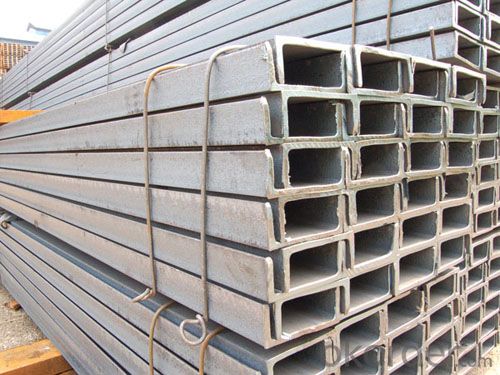
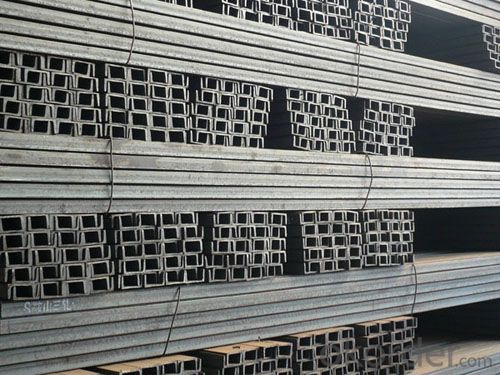
- Q: What are the different methods of cutting steel channels?
- There are several different methods of cutting steel channels, including using saws, plasma cutters, waterjet cutting machines, and laser cutting technology. Each method has its own advantages and disadvantages, depending on factors such as the desired precision, speed, and cost.
- Q: Can steel channels be used in residential construction?
- Yes, steel channels can be used in residential construction. They are commonly used as structural components for framing and supporting walls, floors, and roofs in residential buildings. Steel channels offer high strength and durability, making them suitable for various construction applications.
- Q: Are steel channels suitable for railway infrastructure?
- Yes, steel channels are suitable for railway infrastructure. They provide excellent strength and durability, making them ideal for supporting heavy loads and withstanding the wear and tear of train operations. Steel channels also offer flexibility in design and can be easily fabricated to meet specific railway requirements. Additionally, steel's resistance to corrosion and its low maintenance needs make it a cost-effective choice for long-term railway infrastructure projects.
- Q: How much is the load-bearing capacity of No. 10 I-beam per metre?
- No problem. Generally, the wardrobe is 550-650 millimeters deep. Two are enough.
- Q: Larry Midas in seeking to inform how to model such as: steel, double steel, double channel
- If civil is set in the channel, double cross section library inside, Larry is through the section properties of I-steel calculator, drawing DXF graphics in CAD, import
- Q: Are steel channels suitable for use in bridges?
- Yes, steel channels are commonly used in the construction of bridges due to their high strength, durability, and ability to support heavy loads. They provide structural support and stability, making them suitable for use in bridges.
- Q: What's the size of channel 16, please? Thank you!
- 16A - H height 160mm, B leg width 63mm, D waist thickness 6.5mm - sectional area 21.962/ square cm, weight 17.240kg/m16b - H height 160mm, B leg width 65mm, D waist thickness 8.5mm - sectional area 25.162/ square cm, weight 19.752kg/m
- Q: How do steel channels contribute to the stability of a structure during tornadoes?
- Steel channels contribute to the stability of a structure during tornadoes by providing structural support and reinforcement. They are typically used as beams or columns to distribute loads and resist the strong wind forces generated by tornadoes. The high strength and rigidity of steel channels enable them to withstand the intense pressures and vibrations caused by tornadoes, helping to prevent structural failure and collapse.
- Q: Can steel channels be used for noise reduction purposes?
- Yes, steel channels can be used for noise reduction purposes. Steel channels, also known as acoustic metal channels, are often used as part of a soundproofing system in buildings and structures. They are designed to minimize the transmission of sound by absorbing and dampening noise vibrations. Steel channels are typically made from high-quality steel and have specific dimensions and shapes that help improve their acoustic properties. They are often installed between walls, floors, or ceilings to create a barrier that prevents sound from passing through. The effectiveness of steel channels in reducing noise depends on various factors, such as the thickness and material of the channel, the type and frequency of the noise, and the overall soundproofing system in place. When properly installed and combined with other soundproofing materials like insulation, acoustic panels, or mass-loaded vinyl, steel channels can significantly reduce the amount of noise that enters or leaves a space. It is important to note that while steel channels can be effective in reducing noise, they may not completely eliminate all sounds. Some low-frequency or high-intensity noises may still penetrate through the soundproofing system. Therefore, it is crucial to consult with professionals or acoustic engineers to determine the most suitable soundproofing solutions based on specific requirements and noise levels.
- Q: Are steel channels suitable for electrical installations?
- Indeed, electrical installations can indeed benefit from the use of steel channels. Due to their robustness and durability, steel channels are frequently employed for cable management and support in electrical setups. By utilizing steel channels, one can establish a dependable and secure means of routing and safeguarding electrical cables, thereby minimizing the likelihood of harm and ensuring an orderly and systematic installation. Moreover, steel channels boast exceptional fire and impact resistance, rendering them a prudent selection for electrical applications. Furthermore, their availability in a multitude of sizes and configurations allows for flexibility when designing and tailoring electrical systems.
Send your message to us
JIS U CHANEEL 5-300mm or High Quality Hot Rolled
- Loading Port:
- China Main Port
- Payment Terms:
- TT or LC
- Min Order Qty:
- -
- Supply Capability:
- -
OKorder Service Pledge
OKorder Financial Service
Similar products
Hot products
Hot Searches
Related keywords




